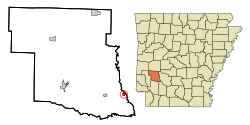Antoine, Arkansas
| Antoine, Arkansas | |
|---|---|
| Town | |
 Location in Pike County and the state of Arkansas |
|
| Coordinates: 34°2′10″N 93°25′18″W / 34.03611°N 93.42167°WCoordinates: 34°2′10″N 93°25′18″W / 34.03611°N 93.42167°W | |
| Country | United States |
| State | Arkansas |
| County | Pike |
| Area | |
| • Total | 0.5 sq mi (1.3 km2) |
| • Land | 0.5 sq mi (1.3 km2) |
| • Water | 0 sq mi (0 km2) |
| Elevation | 299 ft (91 m) |
| Population (2000) | |
| • Total | 156 |
| • Density | 312/sq mi (120/km2) |
| Time zone | Central (CST) (UTC-6) |
| • Summer (DST) | CDT (UTC-5) |
| ZIP code | 71922 |
| Area code(s) | 870 |
| FIPS code | 05-01540 |
| GNIS feature ID | 0076183 |
Antoine is a town in Pike County, Arkansas, United States, along the Antoine River. The population was 156 according to the 2000 census.
Antoine is located at 34°2′10″N 93°25′18″W / 34.03611°N 93.42167°W (34.036183, -93.421787). It is located on hills immediately west of the Antoine River.
According to the United States Census Bureau, the town has a total area of 1.3 km² (0.5 mi²), all land.
Elevation is 300 feet (91 m) above sea level.
The town of Antoine began as a stopping point on the old Southwest Trail to Texas in the early 19th century. It was named for a French trapper who was found dead at his camp along the road (the site of the present town cemetery). The only identification found on the man was his first name, "Antoine". He was buried on the hill by the river and the gravesite became a landmark for travelers. Eventually, the name was given to the river and to the town that grew up beside it. Antoine's grave is located within the bounds of the town cemetery, although the marker has disappeared over time. There are also two Bois-D'Arc marker-trees from the Southwest Trail that remain alive within the town, both located on what is now Main Street/Arkansas Highway 29.
In spite of a nearby skirmish, the town suffered only minor damage during the Civil War, remaining in Confederate hands until 1865. In the late 1860s and early 1870s, a major railroad line was established across Southwest Arkansas. This event was of critical importance to the history of Antoine but the new route was established about 20 miles (32 km) southeast of the former main artery of commerce (the Southwest Trail), and thereby bypassed Antoine. As a result, businesses and settlers abandoned towns along the old route, and the town began a slow decline from which it ultimately never recovered.
...
Wikipedia
